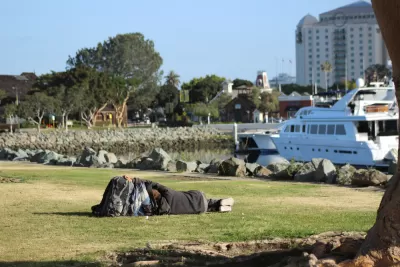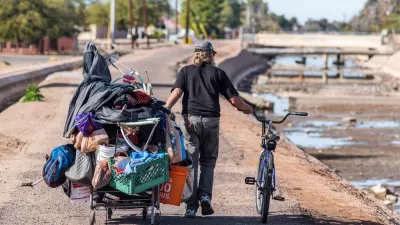The city’s new $6.5 million "bridge shelters" are providing a place to stay, but not accomplishing what they set out to do.

In the aftermath of the Hepatitis A outbreak last year, San Diego established three "bridge shelters," which originally were supposed to be a place for people who already had been given a housing subsidy but had not yet been matched with a permanent place to live.
But while hundreds of people have gone in, or gone in and come out and gone in again, only a fraction have been moved into homes or apartments.
"Critics," writes John Wilkins of the Union-Tribune, "say the poor performance is a reflection of a dysfunctional system that overemphasizes emergency shelters and hasn’t figured out how to align the community’s resources with the longer-term needs of the homeless."
San Diego has the fourth-largest homeless population in the nation, in part because it suffers from the same affordability crisis as other big cities in California (and elsewhere). Downtown San Diego doubled its number of housing units between 2010 and 2015, but saw rents double as well.
FULL STORY: City's shelters falling short of goals in finding permanent housing for the homeless

Alabama: Trump Terminates Settlements for Black Communities Harmed By Raw Sewage
Trump deemed the landmark civil rights agreement “illegal DEI and environmental justice policy.”

Study: Maui’s Plan to Convert Vacation Rentals to Long-Term Housing Could Cause Nearly $1 Billion Economic Loss
The plan would reduce visitor accommodation by 25% resulting in 1,900 jobs lost.

Why Should We Subsidize Public Transportation?
Many public transit agencies face financial stress due to rising costs, declining fare revenue, and declining subsidies. Transit advocates must provide a strong business case for increasing public transit funding.

Paris Bike Boom Leads to Steep Drop in Air Pollution
The French city’s air quality has improved dramatically in the past 20 years, coinciding with a growth in cycling.

Why Housing Costs More to Build in California Than in Texas
Hard costs like labor and materials combined with ‘soft’ costs such as permitting make building in the San Francisco Bay Area almost three times as costly as in Texas cities.

San Diego County Sees a Rise in Urban Coyotes
San Diego County experiences a rise in urban coyotes, as sightings become prevalent throughout its urban neighbourhoods and surrounding areas.
Urban Design for Planners 1: Software Tools
This six-course series explores essential urban design concepts using open source software and equips planners with the tools they need to participate fully in the urban design process.
Planning for Universal Design
Learn the tools for implementing Universal Design in planning regulations.
Smith Gee Studio
Alamo Area Metropolitan Planning Organization
City of Santa Clarita
Institute for Housing and Urban Development Studies (IHS)
City of Grandview
Harvard GSD Executive Education
Toledo-Lucas County Plan Commissions
Salt Lake City
NYU Wagner Graduate School of Public Service





























